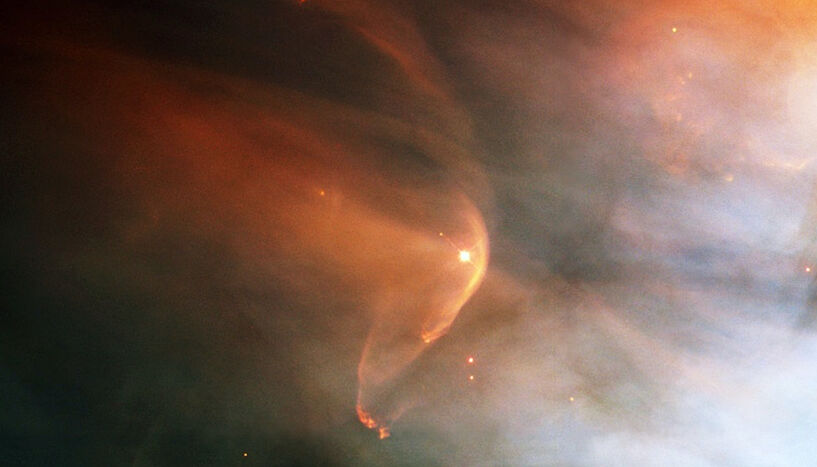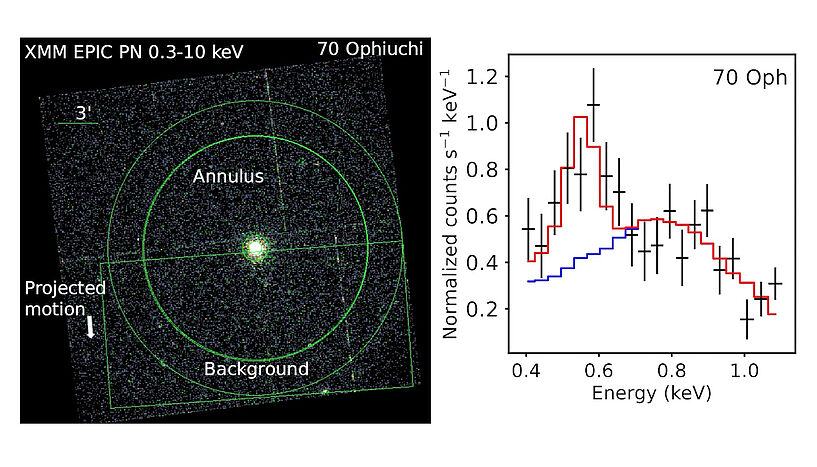Stellar winds of three sun-like stars detected for the first time
12. April 2024Astrophysicists were able to quantify the mass loss of stars via their stellar winds
An international research team led by a researcher from the University of Vienna has for the first time directly detected stellar winds from three Sun-like stars by recording the X-ray emission from their astrospheres, and placed constraints on the mass loss rate of the stars via their stellar winds. The study is currently published in Nature Astronomy.
Astrospheres, stellar analogues of the heliosphere that surrounds our solar system, are very hot plasma bubbles blown by stellar winds into the interstellar medium, a space filled with gas and dust. The study of the stellar winds of low-mass stars similar to the Sun allows us to understand stellar and planetary evolution, and ultimately the history and future of our own star and solar system. Stellar winds drive many processes that evaporate planetary atmospheres into space and therefore lead to atmospheric mass loss.
Although escape rates of planets over an hour or even a year are tiny, they operate over long geological periods. The losses accumulate and can be a decisive factor for a planet evolving into a habitable world or an airless rock. Despite their importance for the evolution of both stars and planets, winds of Sun-like stars are notoriously difficult to constrain. Mainly composed of protons and electrons, they also contain a small quantity of heavier highly charged ions (e.g. oxygen, carbon). It is these ions which, by capturing electrons from the neutrals of the interstellar medium around the star, emit X-rays.
X-ray emission from astropheres detected
An international research team led by Kristina Kislyakova, Senior Scientist at the Department of Astrophysics of the University of Vienna, has detected for the first time the X-ray emission from the astrospheres around three sun-like stars, so called main sequence stars which are stars in the prime of their life, and has thus recorded such winds for the first time directly, allowing them to place constraints on the mass loss rate of the stars via their stellar winds.
These results, based on observations with the XMM-Newton space telescope, are currently published in Nature Astronomy. The researchers observed the spectral fingerprints (so-called spectral lines) of the oxygen ions with XMM-Newton and were able to determine the quantity of oxygen and ultimately the total mass of stellar wind emitted by the stars. For the three stars with detected astrospheres, named 70 Ophiuchi, epsilon Eridani, and 61 Cygni, the researchers estimated their mass loss rates to be 66.5±11.1, 15.6±4.4, and 9.6±4.1 times the solar mass loss rate, respectively. This means that the winds from these stars are much stronger than the solar wind, which might be explained by stronger magnetic activity of these stars.
"In the solar system, solar wind charge exchange emission has been observed from planets, comets, and the heliosphere and provides a natural laboratory to study the solar wind’s composition", explains the lead author of the study, Kristina Kislyakova. "Observing this emission from distant stars is much more tricky due to the faintness of the signal. In addition to that, the distance to the stars makes it very difficult to disentangle the signal emitted by the astrosphere from the actual X-ray emission of the star itself, part of which is "spread" over the field-of-view of the telescope due to instrumental effects. We have developed a new algorithm to disentangle the stellar and the astrospheric contributions to the emission and detected charge exchange signals originating from stellar wind oxygen ions and the surrounding neutral interstellar medium of three main-sequence stars. This has been the first time X-ray charge exchange emission from astrospheres of such stars has been detected. Our estimated mass loss rates can be used as a benchmark for stellar wind models and expand our limited observational evidence for the winds of Sun-like stars."
Co-author Manuel Güdel, also of the University of Vienna, adds, "there have been world-wide efforts over three decades to substantiate the presence of winds around Sun-like stars and measure their strengths, but so far only indirect evidence based on their secondary effects on the star or its environment alluded to the existence of such winds; our group previously tried to detect radio emission from the winds but could only place upper limits to the wind strengths while not detecting the winds themselves. Our new X-ray based results pave the way to finding and even imaging these winds directly and studying their interactions with surrounding planets."
"In the future, this method of direct detection of stellar winds in X-rays will be facilitated thanks to future high resolution instruments, like the X-IFU spectrometer of the European Athena mission. The high spectral resolution of X-IFU will resolve the finer structure and emission ratio of the oxygen lines (as well as other fainter lines), that are hard to distinguish with XMM's CCD resolution, and provide additional constraints on the emission mechanism; thermal emission from the stars, or non-thermal charge exchange from the astrospheres." - explains CNRS researcher Dimitra Koutroumpa, a co-author of the study.
Original Publication in Nature Astronomy:
K.G. Kislyakova, M. Güdel, D. Koutroumpa, J.A. Carter, C.M. Lisse, S. Boro Saikia: X-ray detection of astrospheres around three main-sequence stars and their mass-loss rates. 2024.
https://www.nature.com/articles/s41550-024-02222-x
Pictures:
Fig. 1: Infrared image of the shockwave (red arc) created by the massive giant star Zeta Ophiuchi in an interstellar dust cloud. The tenuous winds of sun-like main-sequence stars are much more difficult to observe C: NASA/JPL-Caltech; NASA and The Hubble Heritage Team (STScI/AURA); C. R. O'Dell, Vanderbilt University
Fig. 2: XMM-Newton X-ray image of the star 70 Ophiuchi (left) and the X-ray emission from the region ("Annulus") surrounding the star represented in a spectrum over the energy of the X-ray photons (right). Most of the emission consists of X-ray photons from the star itself but scattered within the observing telescope and across the camera (approximated by the model shown with the blue line), but there is a significant contribution around the oxygen K-alpha line at an energy of 0.56 keV that originates from the extended astrosphere rather than from the star (this contribution is included in the red model) C: Kislyakova et al. Nature Astronomy, 10.1038/s41550-024-02222-x, 2024
More space news in our science magazine Rduolphina
You can read more about space research at the University of Vienna in the article Europe in the Space Race in the University of Vienna's science magazine Rudolphina or in the overarching section Nature, Climate and the Cosmos.
Scientific contact
Dr. Kristina Kislyakova
Institut für AstrophysikUniversität Wien
1180 - Wien, Türkenschanzstraße 17
+43 1 4277-53817
+43 660 162 1177
kristina.kislyakova@univie.ac.at
Further inquiry
Mag. Alexandra Frey
Media Relations ManagerUniversität Wien
1010 - Wien, Universitätsring 1
+43-1-4277-17533
+43-664-8175675
alexandra.frey@univie.ac.at
Downloads:
202403xx_Kislyakova_Abb1_01.jpg
File size: 122,85 KB
202403xx_Kislyakova_Abb2_01.jpg
File size: 520,02 KB


